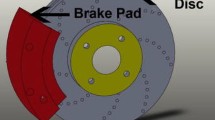Abstract
Thin layer activation technique (TLA) has been used for measurement of wear rate of disc gears under lubricated condition. A synthetic base lubricant was blended with four different types of additives, such as, hexagonal boron nitride (h-BN), molybdenum disulphide (MoS2), graphite and copper nanoparticles (Cu np). The wear rate of the disc gear was measured in presence of individual lubricant formulations. The aim of the current study is to examine the effect of different additives on anti-wear behavior of the synthetic heavy duty gear lubricant using TLA technique. The lubricant formulation containing h-BN showed best anti-wear property among all the formulations and the wear rate in this case was found to be minimum from all other cases.






Similar content being viewed by others
References
Minami I (2017) Molecular science of lubricant additives. Appl Sci 7:445
Wu YY, Tsui WC, Liu TC (2006) Experimental analysis of tribological properties of lubricating oils with nanoparticle additives. Wear 262:819–825
Omrani E, Menezes PL, Rohtgi PK (2019) Effect of micro- and nano-sized carbonous solid lubricants as oil additives in nanofluid on tribological properties. Lubricants 7:25
Zhang W, Zhou M, Zhu HW (2011) Tribological properties of oleic acid-modified grapheme as lubricant oil additives. J Phys D 44:205303
Mistry KK, Pol VG, Thackeray MM, Wen J, Miller DJ, Erdemir A (2015) Synthesis and tribology of micro-carbon sphere additives for enhanced lubrication. Tribol Trans 58:474–480
IAEA Techdoc-924 (1997) The thin layer activation method and its application in industry. IAEA, Vienna
Scherege M, Pohlmann K, Gerve A (2003) Wear measurement using radionuclide-technique (RNT). Wear 254:801–817
Conlon TW (1974) Thin layer activation by accelerated ions-application to measurement of industrial wear. Wear 29:69–80
Ivanov EA, Pascovici G, Racolta PM (1993) A nuclear scanning method for estimating wear level non uniformities. Nucl Instrum Methods Phys Res B 82:604–606
Biswal J, Thakre GD, Pant H, Samantray JS, Arya PK, Sharma SC, Gupta AK (2017) Investigation of anti-wear performance of automobile lubricants using thin layer activation analysis technique. Nucl Instrum Methods Phys Res B 399:69–73
Chowdhury DP, Chaudhuri J, Raju VS, Das SK, Bhatacharjee BB, Gangadharan S (1989) Study of wear between piston ring and cylinder housing of an internal combustion engine by thin layer activation technique. Nucl Instrum Methods Phys Res B 42:375–378
Biswal J, Pant HJ, Sharma SC, Gupta AK (2019) Investigation of effect of an amine inhibitor on corrosion of carbon steel by using thin layer activation technique. J Radioanal Nucl Chem. https://doi.org/10.1007/s10967-019-06710-7
Gupta AK, Bhagwat PV, Choudhury RK (2009) Developmental activities at BARC-TIFR pelletron accelerator facility. In: Proceedings of HIAT09, Venice, Italy
Thin Layer Activation (TLA) technique for wear measurement, IAEA. Accessed 15 Mar 2020. https://www-nds.iaea.org/tla/
Yalcin C (2018) Data needs for the theoretical calibration curve of thin layer activation method. Int J Adv Automot Technol 2:89–97
Erdemir A (2001) Solid lubricants and self-lubricating films. In: Modern tribology handbook, vol 2, Ch 22. CRC Press
Menezes PL, Nosonovsky M, Ingole SP, Kailash SV, Lovell MR (2013) Tribology for scientists and engineers: from basic to advanced concepts. Springer, New York
Lineira del Rio JM, Guimarey MJG, Comunas MJP, Lopez ER, Prado JI, Lugo L, Fernandez J (2019) Tribological and thermophysical properties of environmentally-friendly lubricants based on trimethylolpropane trioleate with hexagonal boron nitride nanoparticles as an additive. Coatings 9:509
Gulzar M, Masjuki HH, Kalam MA, Varman M, Zulkifli NWM, Mufti RA, Zahid R (2016) Tribological performance of nanoparticles as lubricating oil additives. J Nanopart Res 18:223
Zhou J, Wu Z, Zhang Z, Liu W, Xue Q (2000) Tribological behavior and lubricating mechanism of Cu nanoparticles in oil. Tribol Lett 8:213–218
Author information
Authors and Affiliations
Corresponding author
Additional information
Publisher's Note
Springer Nature remains neutral with regard to jurisdictional claims in published maps and institutional affiliations.
Rights and permissions
About this article
Cite this article
Biswal, J., Pant, H.J., Thakre, G.D. et al. Evaluation of anti-wear properties of automobile lubricant with different additives using thin layer activation technique. J Radioanal Nucl Chem 325, 795–800 (2020). https://doi.org/10.1007/s10967-020-07146-0
Received:
Published:
Issue Date:
DOI: https://doi.org/10.1007/s10967-020-07146-0



